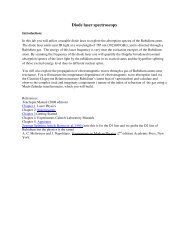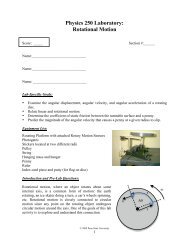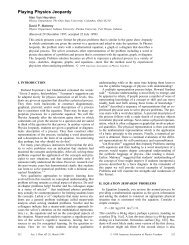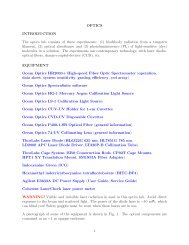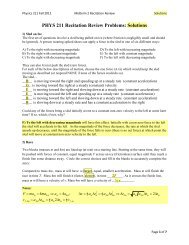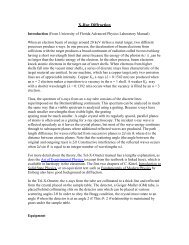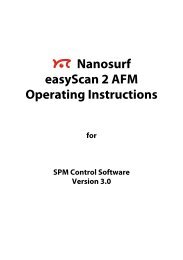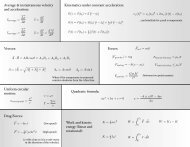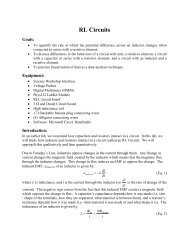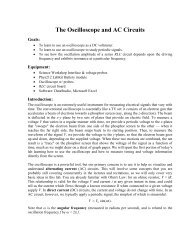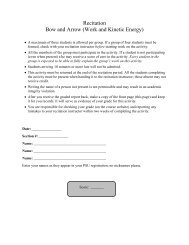Section 001 Syllabus - Penn State University
Section 001 Syllabus - Penn State University
Section 001 Syllabus - Penn State University
Create successful ePaper yourself
Turn your PDF publications into a flip-book with our unique Google optimized e-Paper software.
PHYS 457 Experimental Physics (1- or 2-credit)<br />
PHYS 457W Experimental Physics (3-credit)<br />
Spring 2013 <strong>Section</strong> <strong>001</strong>: MW 02:30 pm - 05:30 pm, 309 and 310 OSMOND<br />
Instructor: J. D. Maynard<br />
Email: maynard@phys.psu.edu<br />
Telephone: 865-6353<br />
Office: 330 Davey Lab<br />
Office Hours: By appointment<br />
Teaching Assistant (TA): Greg Harkay<br />
Email: gjh157@psu.edu<br />
Office: Davey 332<br />
Office Hours: By appointment<br />
Webpage: http://intro.phys.psu.edu/class/p457/<strong>Syllabus</strong>SP13 <strong>001</strong>.pdf<br />
Textbook:<br />
Required reading: “The Science of Scientific Writing”, G. D. Gopen and J. A. Swan<br />
(17 pages). There will be a quiz on this material on Wednesday, January 16, 2013.<br />
Short introductions to each experiment, including links to documentation for most instruments<br />
to be used, can be found in the main Physics 457 webpage.<br />
Students are also encouraged to use resources available in libraries or online for the background<br />
of each experiment. The book, Experiments in Modern Physics, by A Melissinos and<br />
J. Napolitano, is on reserve in the Physics Library.<br />
Course Outline:<br />
Purpose of the course: To provide a general introduction to experimental techniques and<br />
instrumentation used in modern physics research labs, and to teach students how to write<br />
effective scientific papers. While the instructor and the teaching assistants will be available to<br />
help, the students should try to undertake the experiments on their own as much as possible.<br />
For writing, students are encouraged to get help from Professor Maynard if desired.<br />
Organization: Students will do experiments in teams of two. Students taking the course in<br />
the 3-credit option will do three short experiments and one long experiment. Those taking<br />
the course in the 2-credit option will do four short experiments.<br />
For short experiments, each team is required to choose one experiment from each of the three<br />
categories (see main Phys 457 webpage). Students with the 2-credit option can choose the<br />
last short experiment in any category.<br />
The best way to minimize difficulties with the experiments is to follow the detailed lab<br />
manuals very carefully; the lab manuals, available online, should be read from beginning to<br />
end before beginning the experiment. Do not remove hardcopy manuals or any item<br />
from the lab room.<br />
During the setup of the experiment, data acquisition, etc., you will take notes, recording<br />
everything relevant to the experiment, in a lab notebook.<br />
Lab papers: The papers which you write on the lab experiments are an important component<br />
of the course, and they comprise much of your grade. You need to devote significant<br />
effort in writing good papers. It is crucial to follow the ideas in “The Science of Scientific<br />
Writing” and the more detailed guidelines in the appendix at the end of this syllabus. A<br />
lecture aimed at helping you maximize the grades on your lab papers will be presented after<br />
1
the quiz on “The Science of Scientific Writing” (see the Calendar below). While the data<br />
will be shared by two team members, each student will write his/her own experiment paper;<br />
do not collaborate on the writing. The due dates for paper submission are indicated in the<br />
Calendar below.<br />
NOTE: A crucial part of the paper is the introduction and “sales pitch”, and you can get<br />
help from Professor Maynard for this part. Much of your paper will be a discussion of the<br />
procedure for the experiment, and in nearly all cases you can write this part by paraphrasing<br />
the detailed manual for the experiment. In any case, you must follow the guidelines in the<br />
appendix at the end of this syllabus.<br />
For the long experiment, you are required to turn in a preliminary paper on the date as<br />
indicated in the calendar. The preliminary paper should include the introduction and the<br />
theory sections, and the results you have (you should have most data by then) The final<br />
version of the paper on the long experiment will be due the last day of class.<br />
End-of-Semester Presentation: There will be a presentation at the end of the semester<br />
for all students. PHYS 457W (3 credit) students will present the long experiment as a team<br />
using a graphical slide (digital projection) lecture. PHYS 457 (2 credit) students will each<br />
present a short experiment. You may use LaTex with Adobe Reader, etc.<br />
Grading:<br />
PHYS 457W (3-credit): 10% for the “Science of Scientific Writing” quiz, 14% for each<br />
short experiment and 28% for the long experiment, 10% for the presentation, and 10% for<br />
overall performance.<br />
PHYS 457 (2-credit): 5% for the “Science of Scientific Writing” quiz, 19% for each short<br />
experiment, 10% for the presentation, and 9% for overall performance.<br />
The presentation will be graded mainly on the clarity, general performance, and understanding<br />
of the experiment. The guidelines for the papers are also relevant for the presentation.<br />
Format for the papers:<br />
1. The papers should be limited to 5-6 pages for short experiments and 10-15 pages for long<br />
experiments, excluding illustrating figures and plots of experimental results.<br />
2. Use 12-point fonts, 1.5-line spacing and 2.5 cm margins for your papers.<br />
3. It is not required, but it is worth learning LaTex for scientific papers.<br />
4. Papers should be turned in hard copy (single sided) or electronically in pdf format to<br />
maynard@phys.psu.edu.<br />
Guidelines for the presentation:<br />
1. The attitude for the presentations will be informal.<br />
2. Each presentation group will have 10 minutes for presentation and 2 minutes for questions<br />
and answers.<br />
3. Contents: consistent with the papers<br />
4. Format will be graphical slides (digital) with lecture. A computer and a digital projector<br />
will be provided for the presentation. Please bring your file to the TA to preload your<br />
presentation.<br />
2
Safety and Responsibility:<br />
Radiation Safety: No food or drink is allowed in 310 Osmond. Failure to comply will result<br />
in being asked to drop the course. Some experiments require you use low-dose radioactive<br />
sources. If you do these experiments you will read more about radiation safety.<br />
Chemical Safety: Some experiments require that you use chemicals. None of these are<br />
particularly dangerous but you should consult the instructor or TA for proper handling and<br />
disposing of these chemicals.<br />
Laser safety: Some experiments use high power lasers, and you should follow the safety<br />
guidelines in the lab manuals or consult the instructor or TA when using these lasers.<br />
Responsible conduct of Research: As described in The <strong>Penn</strong> <strong>State</strong> Principles, academic<br />
integrity is the basic guiding principle for all academic activity at <strong>Penn</strong> <strong>State</strong> <strong>University</strong>,<br />
allowing the pursuit of scholarly activity in an open, honest, and responsible manner. We<br />
expect that each student will practice integrity in regard to all academic assignments and will<br />
not tolerate or engage in acts of falsification, misrepresentation, or deception. To protect the<br />
fundamental ethical principles of the <strong>University</strong> community and the worth of work completed<br />
by others, we shall record and report to the Office of Judicial Affairs all instances of academic<br />
dishonesty.<br />
Calendar:<br />
week dates activity<br />
1 1/7, 1/9 No class on 1/7; selection of labs and partners on 1/9.<br />
2 1/14, 1/16 1st short experiment; quiz on “Science of Scientific<br />
Writing” on 1/16.<br />
3 1/21, 1/23 No class 1/21; 1st short experiment.<br />
4 1/28, 1/30 1st short experiment; if possible start 2nd short experiment.<br />
5 2/4, 2/6 2nd short experiment; paper on exp. 1 due Monday 2/4.<br />
6 2/11, 2/13 2rd short experiment.<br />
7 2/18, 2/20 3rd short experiment; paper on exp. 2 due Monday 2/18.<br />
8 2/25, 2/27 3rd short experiment.<br />
9 3/4, 3/6 Spring break. No class.<br />
10 3/11, 3/13 4th short or long experiment; paper on 3rd exp. 3 due Monday 3/11.<br />
11 3/18, 3/20 4th short or long experiment.<br />
12 3/25, 3/27 4th short or long experiment.<br />
13 4/1, 4/3 4th short or long experiment.<br />
14 4/8, 4/10 Long experiment; paper on 4th short exp. and preliminary paper on<br />
long exp. due Monday 4/8.<br />
15 4/15, 4/17 Make-up week for the long experiment.<br />
16 4/22, 4/24 Presentations; final version of paper on long exp. due Friday 4/26.<br />
17 4/29, 5/3 Finals week. No class.<br />
3
APPENDIX: Crucial comments on writing experimental physics papers<br />
1. You should be writing a paper in the style of a physics journal, such as Physical Review<br />
Letters. You are not writing an “instruction manual”, and while you are writing an<br />
“undergraduate lab report”, you should make it read like a Phys. Rev. Lett. as much as<br />
possible.<br />
2. Define, collect and organize information about the physics which is the object of the<br />
experimental measurement. Make sure you have mastered it so that you can put it in your<br />
own words.<br />
3. Think up a “sales pitch” about why the object physics is important. Think about a<br />
succinct and efficient way of stating it.<br />
4. Define, collect and organize information about the method of measurement of the object<br />
physics and the physics (or engineering) which is involved. Make sure you have mastered it<br />
so that you can put it in your own words.<br />
5. In developing a paper on a science experiment, first do all of the figures and tables, in<br />
final form. With the figures and tables done, much of the paper will “write itself”; that<br />
is, it is usually straightforward to write a logical flow of sentences which describe a figure,<br />
whether it is an apparatus setup, electronics setup, measured data, etc.<br />
6. Even though you may have a very clear figure, you still must describe it in words. You<br />
must assume that the reader has not even looked at the figure. See item III.E. below.<br />
7. Each paragraph must begin with a “topic sentence”. Every sentence must have only “old<br />
information” in the topic position and “new information” must be in the stress position. A<br />
paragraph should go like this: “action verb (if possible) . action<br />
verb (if possible) . action verb (if possible) . etc.”<br />
The topic position does not have to be but could be with m < n. The<br />
in the topic position can be the exact same words as the in a preceding<br />
stress position.<br />
This structure is to avoid the (Number One) mistake where the writer makes “statement A”,<br />
and then follows the statement with sentences which explain “statement A”. The problem<br />
is that the reader reads “statement A”, doesn’t understand it, reads it again, then re-reads<br />
preceding sentences trying to find out what he/she must have missed. The reader decides<br />
the paper can’t be understood and gives up without ever reading the subsequent sentences<br />
which contain the explanation of “statement A”. Examples of wording which helps somewhat<br />
are as follows:<br />
1. As will be explained later, “statement A”.<br />
2. It has been found that “statement A” [reference].<br />
3. It is important to understand that “statement A”. [Because you say it is important, the<br />
reader will continue reading in anticipation that an explanation of something important<br />
will be provided.]<br />
Just a few words indicate to the reader that an explanation “will” or “can” be found, so<br />
he/she keeps reading and discovers the explanatory sentences. However, the best fix is to<br />
follow the recommended structure, putting “statement A” after the material that leads up<br />
4
to it.<br />
8. End a paragraph with a “linking sentence” which indicates what the next paragraph will<br />
be about. A useful method is to begin the next paragraph with a topic sentence whose topic<br />
position is occupied with the exact same words as presented in the linking sentence of the<br />
previous paragraph.<br />
Example:<br />
“The magnetic moment of the proton will be measured using a nuclear magnetic resonance<br />
(NMR) apparatus; before describing this apparatus, it would be worthwhile to first discuss<br />
the physics of the NMR effect.<br />
The NMR effect involves the ....”<br />
The paragraphs in your first draft may not follow items 7) and 8). You should revise until<br />
items 7) and 8) are followed; it is always possible to do this.<br />
9. It may seem like items 7) and 8) above would produce inelegant writing and short,<br />
choppy sentences. You can improve things by using transition words, action verbs (see<br />
below), prepositional phrases, semicolons, etc.<br />
10. The abstract is not part of the paper; do not assume that the reader has even read it.<br />
The paper starts with the introduction.<br />
11. A section heading does not give you license to start writing about new information, with<br />
no link to old information. Give backward links and an overview (establish context) in a<br />
topic paragraph. A Phys. Rev. Lett. does not have section headings; try writing without<br />
them.<br />
12. If a backward link goes some distance back, then use phrases such as “As mentioned in<br />
the introduction [section A, etc.], ...”.<br />
13. Make sure words, sentences and paragraphs are conveying relevant information.<br />
14. For compound units, use parallel wording. Example: The article “The Science of<br />
Scientific Writing” shows that the structure of discourse is important, that mixing old and<br />
new information confuses the reader, and that if you follow the guidelines you will get a<br />
good grade.”<br />
15. Miscellaneous: Avoid colloquial wording; it’s inappropriate for a journal article. Avoid<br />
the first person. Do not use forward references to equations. Do not use references as parts<br />
of sentences; instead of “as discussed in [3], ...”, use “as discussed in the literature[3], ...”<br />
Figures and tables must have captions. References should be in the style of Physical Review<br />
Letters.<br />
5
Template for Phys 457 writing:<br />
Abstract: Write it last! It should be short, but it should follow the logical flow of the<br />
introduction and conclusion sections, as discussed below. It must contain the words “this<br />
paper”, as opposed to the words “this experiment” or “this lab”.<br />
I. Introduction: Should introduce the object physics, its importance (sales pitch), the measurement<br />
method and its physics (and/or engineering), some comments about the results,<br />
etc. It must contain the words “this paper”, as opposed to the words “this experiment” or<br />
“this lab”.<br />
A. Each sentence is supposed to go from old information to new, but you have to begin<br />
somewhere. The first sentence can start with something obvious, but it must introduce<br />
the object physics (the subject of the paper!). Example:<br />
1. “Many phenomena of physics are applied in the field of [medicine, industrial<br />
safety, electronics, computers, communication, materials testing, etc.], and one<br />
of the most important is the phenomenon of . The phenomenon involves ...”<br />
2. “Understanding the laws of nature clearly requires accurate knowledge of the<br />
fundamental constants of physics, and one of the most important fundamental<br />
constants is the . The<br />
is important because...”<br />
C. You should have a transition (with a clear link mechanism) from the object physics to<br />
the measurement physics.<br />
D. Each paragraph should follow Comments 7) and 8).<br />
E. The introduction should end with a link to the theory section. Example:<br />
“The and the method used in its measurement<br />
are discussed in more depth, and the relevant formulas are derived, in the next<br />
section.”<br />
II. Theory of the and the method<br />
A. Should include the theory for the object physics and the physics (or engineering) of<br />
the measurement method<br />
B. Minimize (or don’t bother with) history<br />
C. All symbols must be defined. If not already defined, symbols in equations must be<br />
defined immediately following the equation: “F = ma, where F is the net force on a<br />
particle, m is its mass, and a is its acceleration.”<br />
D. Each paragraph should follow Comments 7) and 8).<br />
E. A transition to the Setup or Apparatus section could be: “Now that the and the physics of the method of measurement have been discussed, the<br />
actual experimental apparatus, setup and operation can be described.”<br />
6
III. Experimental Apparatus, Setup and Operation section<br />
A. Write like a Phys. Rev. Lett., not like an instruction manual or lab guide<br />
B. Example of a topic sentence, etc.: “The setup of the apparatus for measuring the<br />
is shown schematically in Fig. 1. The setup is configured to measure<br />
the properties of a sample of sodium fizzphate, indicated as a cylinder in the figure.<br />
The sample is contacted by a transducer which converts the atomic transitions of the<br />
fizzphate into electrical pulses, as discussed in the theory section.”<br />
C. Do not use “laundry lists” of apparatus or steps. Use complete sentences.<br />
D. If the experimental setup involves some special instruments, explain them up front:<br />
“the measurement involves a “lock-in amplifier” whose function is...” or “a key element<br />
(or instrument) in the measurement is a “pulse-height-analyzer”; this instrument...”<br />
or “the gamma rays are detected with a “gas proportional counter”, which operates as<br />
follows:”. If the physics involved in the instruments needs to be discussed, it should<br />
have already been done in the theory section.<br />
E. Describe a setup (or setup figure) in a logical flow (e.g. following the signal) using general<br />
terms for instruments (detector, transducer, preamp, amplifier, lock-in amplifier<br />
(already explained), digital-to-analog converter, digital multimeter, etc.) Do this as<br />
though the reader has not looked at a setup figure!<br />
In referring to a figure, avoid using “(see Fig. 3)”. Figures are too important to<br />
be referred to parenthetically, and commanding the reader is more appropriate for an<br />
instruction manual. Instead, use “The instruments are connected as illustrated [shown,<br />
pictured, etc.] in Fig. 3.”<br />
F. When you first refer to some item, you cannot use the article “the”, because that<br />
would mean that there is only one such item in the whole universe. The first reference<br />
must be to “a lock-in amplifier”; later you may refer to “the lock-in amplifier”, since<br />
an individual instance has been established. However, don’t count on the reader as<br />
having already seen the item in a figure.<br />
G. Use references to provide the manufacturer, model, etc. of particular instruments, e.g.<br />
“recovering the low-level signal from noise was accomplished with a lock-in amplifier[1]”.<br />
H. A possible transition to the Procedure section might be: “The setup was used to<br />
measure the using the procedure described in the next section.”<br />
IV. Procedure<br />
A. Begin the procedure section with a topic paragraph, and subsequent paragraphs or<br />
procedural stages should have topic sentences; there should be good links between<br />
paragraphs.<br />
B. Do not use “laundry lists” of procedural steps. Use complete sentences.<br />
C. Prepare the reader if more details are forthcoming: “While details will be provided<br />
below, the steps of the procedure may be briefly enumerated as follows:”<br />
D. Important steps should have explanations, as to what the step is doing and how.<br />
E. If there is some procedure for data analysis, you could include it in this section. However,<br />
it might fit better in the results section.<br />
7
F. Each paragraph should follow Comments 7) and 8).<br />
G. Example of a link to the Results section: “The procedures described above were followed<br />
under a number of different conditions [temperatures for the sodium fizzphate,<br />
etc.], and the particular conditions and the results obtained are presented in the next<br />
section.”<br />
V. Results and Conclusions<br />
A. A good way to start: “Following the procedures for measurement and data analysis as<br />
discussed in the preceding section, the results of the may be seen in<br />
Fig. 3. [and/or Table I.]”<br />
B. Keep this section, as well as the error analysis, very brief.<br />
C. The conclusion section should return to the “sales pitch” ideas presented in the introduction.<br />
8
From J. Schall, Style for Students: Transition words<br />
The best stylists become masters at artfully placing transition words in pivotal positions-i.e.,<br />
places where the sentence or paragraph meaning shifts slightly. What follows is a handy list<br />
of common transition words and their functions. If you open sentences appropriately with<br />
these words it will help your writing to flow. One caveat though: Always keep the literal<br />
meaning of a transition word in mind as you use it; therefore, do not use “for example”<br />
unless you are introducing an example that links to the preceding information; do not use<br />
“nevertheless” unless you are offering a contrasting point. Note how this paragraph has<br />
required a minimal use of transition words; they should not be forced in where they do not<br />
belong. When you do use them, keep their broader functions (i.e., “causality,” “emphasis,”<br />
etc.) directly in mind.<br />
Causality Emphasis Amplification<br />
Accordingly Above all Again<br />
Consequently Certainly Also<br />
For this reason Clearly Apparently<br />
Hence Indeed Besides<br />
Therefore In fact Equally important<br />
Thus In short Finally<br />
Obviously<br />
First, Second, etc.<br />
Intention Of course Further<br />
For this purpose<br />
In addition<br />
In order to do this Closure Moreover<br />
To this end<br />
In conclusion<br />
With this in mind In sum Detail<br />
On the whole Especially<br />
Location To summarize In particular<br />
Beyond<br />
Namely<br />
Here Similarity Specifically<br />
Nearby Likewise To enumerate<br />
Opposite<br />
Similarly<br />
Overlying (underlying)<br />
Comparison/Contrast<br />
There Time However<br />
To the right (left) Afterward In contrast<br />
At the same time In relation to<br />
Concession Before Nevertheless<br />
At any rate Earlier On the other hand<br />
At least In the meantime Still<br />
Sometimes<br />
Example Later Interpretation<br />
For example Next Fortunately<br />
For instance Preceding this Interestingly<br />
To demonstrate Simultaneously Significantly<br />
To illustrate Soon Surprisingly<br />
9
Active Verbs That Describe Work<br />
yield illustrate illuminate reveal employ<br />
mean suggest clarify indicate represent<br />
prove insist propose imply assert<br />
postulate consider infer state extrapolate<br />
estimate define classify invoke analyze<br />
compare hypothesize synthesize summarize disagree<br />
generalize narrate evaluate simplify measure<br />
note predict introduce report challenge<br />
delineate depict construe interpret provide<br />
acknowledge distinguish inform specify restrict<br />
determine detail sum up designate point out<br />
set forth deduce derive characterize guide<br />
maintain believe speculate present organize<br />
investigate assess determine calculate support<br />
devise construct evaluate attribute obtain<br />
assume argue reiterate discover decide<br />
A Short List of Active Verbs That Describe Phenomena<br />
discharge overlie emanate radiate scatter<br />
exchange separate surround combine eliminate<br />
emit transmit carry bombard exert<br />
exude interact behave exchange absorb<br />
converge extend constrain force elongate<br />
contract trend plunge occur fracture<br />
continue mix slow quicken produce<br />
bond interlock fuse deteriorate migrate<br />
encompass access traverse join dominate<br />
deposit underlie overlap originate isolate<br />
invade permeate evolve divide sinter<br />
reclaim restore abandon contain accrue<br />
precede influence saturate circulate forecast<br />
orient distribute allow lag terminate<br />
activate cease record form transect<br />
condense enrich invert convert alter<br />
link superimpose rotate rupture streamline<br />
appear require ascend descend collapse<br />
superpose crystallize bisect cede coalesce<br />
disperse disseminate disintegrate propel repel<br />
accelerate transfer penetrate halt curb<br />
10



